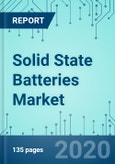The study is designed to give a comprehensive overview of the Solid-State Batteries market segment. Research represents a selection from the mountains of data available of the most relevant and cogent market materials, with selections made by the most senior analysts. Commentary on every aspect of the market from independent analysts creates an independent perspective in the evaluation of the market. In this manner the study presents a comprehensive overview of what is going on in this market, assisting managers with designing market strategies likely to succeed.
Batteries are changing in response to the implementation of wind and solar energy systems. Solid-state batteries represent the next generation of power storage for vehicles. Nanotechnology permits units to be miniaturized, standalone, and portable. Solid-state batteries have advantages in power and density: low-power draw and high-energy-density. They have limitations in that there is difficulty getting high currents across solid-solid interfaces.
Power delivery is different in solid-state batteries, – there is more power per given weight. The very small and very thin size of solid-state battery electrodes helps to reduce the physical size of the sensor or device using the battery. Units can stay in the field longer. Solid-state batteries can store harvested energy.
When combined with energy harvesting solid-state batteries can make a device stay in the field almost indefinitely, last longer, power sensors better.
Temperature is a factor with batteries. The solid-state batteries work in a very broad range of temperatures, making them able to be used for ruggedized applications. Solid-state batteries are ecofriendly. Compared with traditional batteries, solid-state thin-film batteries are less toxic to the environment.
Solid-state battery market driving forces include response to IoT, creating business inflexion by delivering technology that supports entirely new capabilities is a market benefit. Sensor networks are creating demand for solid-state devices. Vendors doubled revenue and almost tripled production volume from first quarter. Multiple customers are moving into production with innovative products after successful trials.
A solid-state battery electrolyte is a solid, not porous liquid. The solid is denser than liquid, contributing to the higher energy density. Charging is complex. In an automotive application, recharge cycles go up, rendering a next-generation battery. The cycles increase by the inverse of the depth of discharge. Long shelf life is a benefit of being a solid-state battery. The fact that the battery housing does not need to deal with gases and vapours as a part of the charging/discharging process is another advantage.
Nanostructured or nano-enabled batteries are a new generation of lithium-ion batteries and battery systems to serve applications and markets. Nano-enabled batteries employ technology at the nano-scale, a scale of minuscule particles that measure less than 100 nanometers, or 100x10-9 meters.
Next-generation solid-state batteries are part of the Lithium-ion battery markets which are expected to reach to $1 trillion in 2026 in response to the adoption of solar and wind energy generation and the rapid adoption of electric vehicles that replace the gasoline-powered vehicles. Global warming is forcing a shift from fuels that are burned to renewable energy generation. Solid-state batteries represent the next generation of lithium-ion batteries and will account for powering electric cars.
Table of Contents
Companies Mentioned (Partial List)
A selection of companies mentioned in this report includes, but is not limited to:
- 1 Blue Solutions
- ATL
- Amperex Technology Ltd. (CATL)
- Amprius® Technologies
- Anheuser-Busch
- Apple
- Aquion Energy
- BASF
- BMW
- Bolloré
- Bosch
- Cymbet
- Dyson / Sakti
- Enovate
- Ford
- Front Edge Technology
- General Motors
- Hyundai
- Ilika
- Ion Storage Systems
- Ionic
- Jiawei
- Johnson Battery Technologies
- MIT
- Mitsui Kinzoku
- Panasonic
- Panasonic
- Pellion
- PolyPlus
- ProLogium
- Quantumscape
- SK Innovation
- SUNY
- Seeo
- Sion Power
- Solid Power
- Sumitomo Electric Industries
- Tesla
- Thermo Scientific
- Tohoku University
- Toyota
- University of Illinois at Urbana
- University of Texas
- Volkswagen Group
- Wildcat Discovery Technologies








